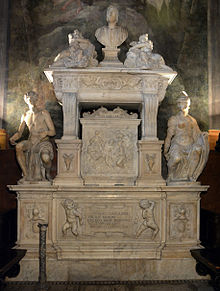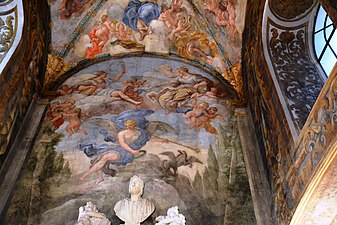Santa Maria del Parto a Mergellina
| Chiesa di Santa Maria del Parto a Mergellina |
|
|---|---|
| Patronage : | Maria |
| Order : | Servites |
| Address: | via Mergellina, Naples |
Coordinates: 40 ° 29 ′ 34.7 " N , 14 ° 7 ′ 52.6" E
Santa Maria del Parto a Mergellina (or Santa Maria del Parto for short ) is a church in Naples , on via Mergellina in the Mergellina district in the Chiaia district . The Italian epithet " del Parto " means " birth " and refers to Mary as the mother of Jesus and as the protector of pregnant and childbearing women.
The church is unusual in several ways, due to its history and location, and is best known as the church of the Neapolitan Renaissance poet Jacopo Sannazaro , for whom an artistically significant funeral monument was also erected in the church.
history
The church was built at the beginning of the 16th century by Jacopo Sannazaro, who lived here on an estate that King Frederick of Aragon had given him in 1497 (according to other sources, 1499). The property previously belonged to the Benedictine monastery of Santi Severino e Sossio .
Sannazaro spent the last years of his life here, building a tower, a house and two stacked chapels, the lower of which was dedicated to the Virgin Mary and the upper to Saint Nazarius - which the poet evidently because of the resemblance to his own name as his Namesake looked at. The lower church was finished in 1524. After the French occupation of 1528, during which Sannazaro's tower was destroyed, he handed over the now almost finished church in 1529 (the year before his death) to Servite monks , known as “ Padri di santa Maria dei Servi ” or “ Servi di Maria ” (servants who called Maria).
The church was given its nickname “ del Parto ” based on Sannazaro's Latin poem De partu Virginis (“About the Birth of the Virgin”), which he wrote in this place.
At Sannazaro's own request, he was buried in the church not far from the grave of his favorite poet Virgil (in today's Parco Vergiliano a Piedigrotta ), and a monument was erected for him. The lower church was later abandoned and converted into a hypogeum , the upper church was expanded and expanded at the request of Sannazaro's heirs Giovanni Carlo Mormile and Simone Moccia. The church was then surrounded by gardens and statues, and the place was so pleasant and idyllic that it was very popular with members of the court of viceroys in the summer.
During the French rule under Joachim Murat (1806–1815), the Servite monastery was abolished like many others and the monks were expelled. The buildings under the church went into private ownership and were rented out as apartments. Gioacchino Rossini, who rented it from the famous impresario Domenico Barbaja , is said to have lived in one of these apartments for several years .
In 1812 the church was handed over to the Confraternita del Santissimo Rosario . and on May 24, 1935 it officially became an independent parish ( parrocchia autonoma ). The Servites were not allowed to return until 1971. Various restoration measures have been carried out in recent years (as of 2018) .
description
Exterior
The church is quite picturesque in the bay of Mergellina right on the shore. To reach it, you have to climb a set of stairs that lead to a kind of narrow terrace that is also the forecourt of the church. Today there are buildings with apartments under the terrace and under the church.
The facade of the church no longer corresponds to the original condition, both in shape and in the current color scheme in dark wine red (as of 2018), it was changed in the 19th century, probably when private apartments were furnished here. The original elements include the arched portal and two small round openings with frescoes showing the portraits of Sannazaro and King Frederick of Aragon (poorly preserved). On the right and left there are panels with inscriptions.
inner space
The interior is a single nave church with three small side chapels - or better: side altars - on the right and left.
In 1520, Sannazaro commissioned Giovanni da Nola to make some wood-carved figures for a nativity scene ; only five of the original 14 figures have survived: Mary and Joseph and three shepherds. Today you are in a side room of the sacristy.
On the baroque main altar made of polychrome marble is a figure of the Virgin Mary with the Child Jesus (1865) created by Francesco Saverio Citarelli in 1865, who is venerated here (according to the name of the church) as the protector of pregnant and childbearing women. In the apse behind it an antique architecture was created, which consists of a large round arch niche, in the center of which there is a small open round arch (behind the Madonna figure); On either side, in front of niches lined with dark red, there are two sculptures of St. James and St. Nazario , created by Bartolomeo Ammanati in a very antique style.
The vault above is decorated with frescoes from the life of the Virgin Mary , which were created by Paolo Guidotti Borghese in 1593: in the middle the Adoration of the Shepherds with a small coronation of Mary above, on the left the Visitation of the Virgin , and on the right the circumcision (see fig.). At the top of a frieze is a distich by Sannazaro about the virgin birth :
“ Virginitas partus discordes tempore longo / Virginis in gremio foedera pacis habet ”.
In the small chapel to the right of the presbytery there is a painting with the Adoration of the Magi by the Flemish painter Cornelis Smet from Mechelen. This picture was given to Sannazaro by King Federico and it was later mistaken for the work of "Giovanni Wan Dick" from Bruges by the art historians Vasari and Galante.
On the first altar on the right is a painting by Leonardo da Pistoia depicting the Archangel Michael slaying the demon . The picture is also notorious as "Diavolo di Mergellina" (Devil Mergellina), and is of cardinal Diomede Carafa have been commissioned, at his request, the demon was presented with the facial features of a beautiful woman. Legend has it that it is a portrait of a lady with whom Diomede was in love, but who did not listen to him and instead had relationships with other men; possibly it was Vittoria Colonna D'Avalos . This legend was also elaborated literarily by the writer Matilde Serao in her volume Leggende Napoletane ("Neapolitan Legends", 1890), and Benedetto Croce reported in 1919 in his Storie e Leggende Napoletane that the Neapolitans were so fascinated by the beautiful face of the demon, that it became common to describe a 'beautiful but cruel woman' who 'does not do a man good' as 'beautiful as the devil of Mergellina' (' bella come il Diavolo di Mergellina ').
Tomb of Jacopo Sannazaro
The most significant work of art in the church is the tomb of Jacopo Sannazaro in a chapel next to the main altar, created by Giovann'Angelo Montorsoli da Poggibonsi and Francesco del Tadda under the influence of Michelangelo , and its sculptural program almost entirely that of Greco-Roman From mythology : on the lower plinth two angels hold an inscription with a text by Pietro Bembo :
" Da Sacro cineri flores: Hic Genealogie Maroni / Sincerus Musa proximus ut Tumulo. (see fig.)
Give flowers to the holy ashes: here lies the Sincerus who is the closest to Virgil's muse , as well as his grave. "
Above, between the pillars of the sarcophagus, there is a bas-relief of a bucolic or Arcadian scene with Neptune , Pan , Marsyas and nymphs , attributed by some to Bartolomeo Ammannati, by others to Silvio Cosini. The sculptures to the right and left of it represent the gods Apollo and Minerva and are works by Ammanati; However, the two figures are biblically reinterpreted by inscriptions as David and Judith (see illustration) - these names are said to have been carved by the monks later because one of the Spanish viceroys threatened to have the tomb removed because it was not Christian, but only show pagan symbolism. The richly decorated sarcophagus above is crowned by the bust of Sannazaro, who is depicted with a laurel wreath as poeta laureatus and named by his Arcadian poet name Actius Sincerus . On either side, two winged putti hold a book and a helmet (or a cornucopia?) As symbols.
The wall behind the monument and the vaulted ceiling were frescoed in 1699 by Nicola Russo, a painter from the school of Francesco Solimena , who painted a winged fama crowning the bust of the poet, behind it Mount Helikon and the winged horse Pegasus , and above it various allegorical figures, u. a. the astronomy , philosophy , grammar and rhetoric .
literature
- Nanà Corsicato: Santuari, luoghi di culto, Religosità popolare: il culto mariano nella Napoli d'oggi. Liguori editore, Naples 2006. ISBN 88-2073-973-9
- Attilio Carrella: La chiesa di Santa Maria del Parto a Mergellina. Soprintendenza per i Beni Artistici e Storici di Napoli, Naples 2009.
Web links
- Ciro La Rosa: La Chiesa di Santa Maria del Parto e la leggenda del diavolo di Mergellina. Website "Brigantino - il portale del Sud" , May 2013, accessed on November 20, 2018 (Italian; source for this article)
- The “Chiesa di Santa Maria del Parto” on the “napoligrafia” website , accessed on November 20, 2018 (Italian; source for this article)
- Website of the church “Santa Maria del Parto a Mergellina” , accessed on November 20, 2018 (Italian; source for this article)
Individual notes
- ↑ a b c d e f g h i j k l m n o p q r s The “Chiesa di Santa Maria del Parto” on the website “napoligrafia” , viewed on November 20, 2018
- ↑ a b c d e f g h i j Brief information about the history of “Santa Maria del Parto a Mergellina” on the Church's website under “storia” , viewed on November 20, 2018
- ↑ a b c d e f g h i j Ciro La Rosa: "La Chiesa di Santa Maria del Parto e la leggenda del diavolo di Mergellina", on the website "Brigantino - il portale del Sud" , May 2013, accessed on 20 November 2018 (Italian; source for this article)
- ↑ Attilio Carrella: La Chiesa di Santa Maria del Parto a Mergellina , Soprintendenza per i Beni Artistici e Storici di Napoli, Naples 2009, pp 99-105.
- ↑ Attilio Carrella: La Chiesa di Santa Maria del Parto a Mergellina , Soprintendenza per i Beni Artistici e Storici di Napoli, Naples 2009, p 69th












